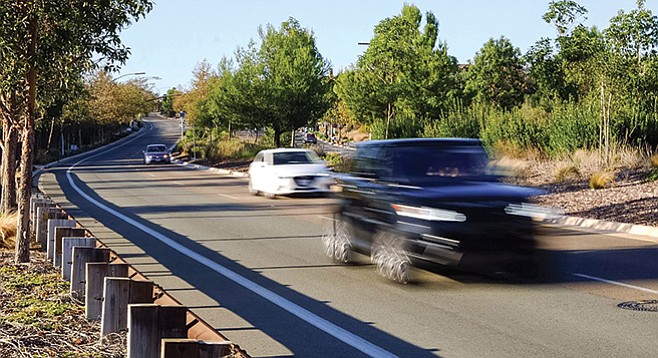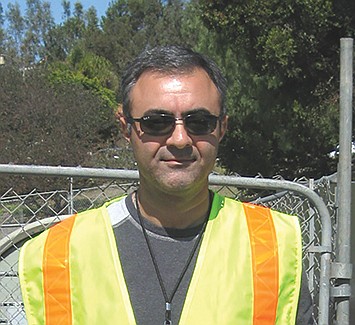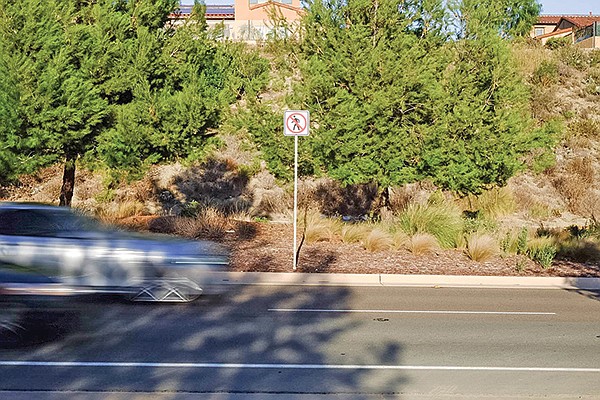 Facebook
Facebook
 X
X
 Instagram
Instagram
 TikTok
TikTok
 Youtube
Youtube

In April 2011 Farhad Bastani, a resident engineer for the City of San Diego, watched drivers punch their accelerators the moment they arrived at the newly widened section of Camino Del Sur, near the intersection with San Dieguito Road in Black Mountain Ranch.
The high speeds and high road elevations near Lusardi Creek concerned him. He feared drivers wouldn’t see pedestrians who were crossing Camino Del Sur to access the popular Santaluz hiking trails until it was too late.

The following day he met with one of his supervisors, Lisa Adams, to report his findings.
During his four years working as a field engineer for the City of San Diego Bastani had discovered other safety issues. In that time, he had learned the department’s unwritten policy for reporting any safety issues; do so verbally and refrain from mentioning them in any emails. Email, according to a 2013 email from then-supervisor David Zoumaras, could potentially make the city liable in case any lawsuits are filed.

To reduce speeding and poor visibility on Camino Del Sur, Bastani recommended installing temporary speed humps or electronic speed-limit signs. His suggestions were not employed.
Three months later, on August 30, 2011, Lawrence Farry was driving over 80 miles per hour on Camino Del Sur, near the intersection with Haaland Glen. Meanwhile 56-year-old Joan Milazzo, her husband Paul, and her sister, who had all been hiking the Del Sur Canyon Trail, were midway across Camino Del Sur walking to pick up the other side of the trail.
Farry saw the two women crossing but was unable to stop. His red Nissan Altima struck and killed Joan Milazzo. Her husband watched from a few feet away.

Bastani saw the emergency vehicles at the scene of the accident. In an email on the following day Bastani told his supervisor, Mike Arnold, about the accident. “…I heard a lady was injured there. I should mention that I have noticed some problem[s] in traffic control implementation and [the subcontractor] was aware of that.”
Arnold was not pleased. “Reporting to me this accident is unrelated to your duties as a city inspector,” Arnold wrote. “Please do not report on such events in the future. In addition, any concerns you have regarding traffic control or anything else related to your project should be brought to the attention of the project manager and the appropriate city staff, but not in this context.”
In 2012, Milazzo’s husband Paul sued the city. He blamed the city for his wife’s death. He believed the city was aware of speeding on Camino Del Sur and did nothing to reduce vehicle speed or prohibit pedestrian crossing.
Attorneys for the city denied any wrongdoing. In legal documents, lawyers stated that the city “did not have actual or constructive notice of the condition of the property in question,” nor was the city responsible for safety issues and poor visibility. City attorneys cited an encroachment agreement it entered with a subcontractor, which indemnified the city in case of any issues with the median and landscaping.
The statement, says Bastani, is grossly inaccurate.
According to Bastani, the city attorney’s office requested information from his replacement on the Camino Del Sur road-widening project and never contacted him directly. “No one ever asked me even one single question in any investigation about the incident in Camino Del Sur, although I was the resident engineer of the project at the time of the incident.”
He says that the city’s unwritten policy was responsible for the death of a mother and wife and prevented her widower from finding out the truth.
Paul Milazzo’s lawsuit was dismissed in 2014. Milazzo’s attorney did not respond to a request for comment. Attempts to reach Milazzo family members were also unsuccessful.
“If this unwritten city policy is not resolved, I have very little doubt that more people will be at risk in the future,” Bastani says during an August interview at a coffee shop in Grantville.
He tosses his hands in the air often when speaking of his time as a city employee. He is passionate. His voice quivers and he stammers trying to find the correct words.
“People have lost their lives because of such unlawful practices. Safety is the most important matter that at no situation should be disregarded.”
Bastani was fired for personnel issues in 2013. According to city documents, Bastani’s supervisors accused him of “threatening and intimidating behavior.” Bastani, on the other hand, says the city is attempting to distract from his complaints about trying to keep employees from using email to report safety issues.
He is currently suing the city for wrongful termination. He believes his supervisors fired him in retaliation for blowing the whistle on the department’s no-email policy.
In the years that followed Milazzo’s death, as the lawsuit languished in superior court, Bastani rebelled against his department’s unspoken email policy. He considered it a threat to public safety. At the same time, he fought to implement safety measures for all road-widening projects.
In May 2013, Bastani emailed Alireza Sabouri, a supervisor in San Diego’s Traffic Engineering division, requesting speed-limit signs be installed before any new lanes are opened, placing temporary speed reducers at the beginning of new lanes to prevent speeding, and the placement of electronic speed-limit indicators.
Bastani’s work to improve public safety and ensure transparency didn’t win him any friends.
That same month, Bastani wrote to then–deputy director of field engineering Zoumaras about the no-email policy.
“Why such sensitivity exists not to use city email for such an important issue [that is supposed] to be our first priority of a public employee?
“Apparently my supervisor does not like to talk about the public safety and the responsibilities of a [resident engineer] through the emails [sic]. Is there any reason that why some people [do] not like discussions about public safety in email?”
Zoumaras responded, “In general, the city is subject to litigation which result from injuries to the public [sic]. Often the plaintiff alleges an unsafe condition, which the city was aware of before the injury. In the past the city has been hurt in court by email communications related to specific safety concerns, which were poorly written, contained erroneous information, and/or wrongly identified something as being a public safety concern. Since litigation and Public Records requests involve discovery of all documents/communications, we are protecting our employer and the people who pay for city services by being mindful of this.”
Spokesperson for the City of San Diego Katie Keach says there is no policy in any city department that prevents employees from reporting safety issues in writing.
“The City of San Diego encourages employees to come forward to report concerns about safety, waste, fraud and abuse in whatever manner is most appropriate to ensure we continually work to strengthen our services to the community,” Keach wrote in an August 17 email.
“The city is looking into how the miscommunication in question could have occurred.”
Experts in government transparency, however, believe that public agencies prefer to keep sensitive topics from the record.
“We certainly know that many agencies try to keep certain conversations ‘off the record’ by not using emails,” says open-government advocate and attorney Kelly Aviles.
Adds Aviles, “Any policy to keep information from being documented is a horrible policy. It is only compounded where the issue relates to safety.”
Bastani says the problem goes much deeper than a fear of legal culpability. He says the problem is with municipal government as a whole. “Many of the managers and supervisors only have a title of public employee, but the only thing on their minds is attending work for eight hours a day, collecting their pensions and retirements. The concept of public service is one of their last priorities.
Bastani vows to continue his fight against the city. In July 2016 he filed his second wrongful termination lawsuit. That lawsuit is now making its way through the court.


In April 2011 Farhad Bastani, a resident engineer for the City of San Diego, watched drivers punch their accelerators the moment they arrived at the newly widened section of Camino Del Sur, near the intersection with San Dieguito Road in Black Mountain Ranch.
The high speeds and high road elevations near Lusardi Creek concerned him. He feared drivers wouldn’t see pedestrians who were crossing Camino Del Sur to access the popular Santaluz hiking trails until it was too late.

The following day he met with one of his supervisors, Lisa Adams, to report his findings.
During his four years working as a field engineer for the City of San Diego Bastani had discovered other safety issues. In that time, he had learned the department’s unwritten policy for reporting any safety issues; do so verbally and refrain from mentioning them in any emails. Email, according to a 2013 email from then-supervisor David Zoumaras, could potentially make the city liable in case any lawsuits are filed.

To reduce speeding and poor visibility on Camino Del Sur, Bastani recommended installing temporary speed humps or electronic speed-limit signs. His suggestions were not employed.
Three months later, on August 30, 2011, Lawrence Farry was driving over 80 miles per hour on Camino Del Sur, near the intersection with Haaland Glen. Meanwhile 56-year-old Joan Milazzo, her husband Paul, and her sister, who had all been hiking the Del Sur Canyon Trail, were midway across Camino Del Sur walking to pick up the other side of the trail.
Farry saw the two women crossing but was unable to stop. His red Nissan Altima struck and killed Joan Milazzo. Her husband watched from a few feet away.

Bastani saw the emergency vehicles at the scene of the accident. In an email on the following day Bastani told his supervisor, Mike Arnold, about the accident. “…I heard a lady was injured there. I should mention that I have noticed some problem[s] in traffic control implementation and [the subcontractor] was aware of that.”
Arnold was not pleased. “Reporting to me this accident is unrelated to your duties as a city inspector,” Arnold wrote. “Please do not report on such events in the future. In addition, any concerns you have regarding traffic control or anything else related to your project should be brought to the attention of the project manager and the appropriate city staff, but not in this context.”
In 2012, Milazzo’s husband Paul sued the city. He blamed the city for his wife’s death. He believed the city was aware of speeding on Camino Del Sur and did nothing to reduce vehicle speed or prohibit pedestrian crossing.
Attorneys for the city denied any wrongdoing. In legal documents, lawyers stated that the city “did not have actual or constructive notice of the condition of the property in question,” nor was the city responsible for safety issues and poor visibility. City attorneys cited an encroachment agreement it entered with a subcontractor, which indemnified the city in case of any issues with the median and landscaping.
The statement, says Bastani, is grossly inaccurate.
According to Bastani, the city attorney’s office requested information from his replacement on the Camino Del Sur road-widening project and never contacted him directly. “No one ever asked me even one single question in any investigation about the incident in Camino Del Sur, although I was the resident engineer of the project at the time of the incident.”
He says that the city’s unwritten policy was responsible for the death of a mother and wife and prevented her widower from finding out the truth.
Paul Milazzo’s lawsuit was dismissed in 2014. Milazzo’s attorney did not respond to a request for comment. Attempts to reach Milazzo family members were also unsuccessful.
“If this unwritten city policy is not resolved, I have very little doubt that more people will be at risk in the future,” Bastani says during an August interview at a coffee shop in Grantville.
He tosses his hands in the air often when speaking of his time as a city employee. He is passionate. His voice quivers and he stammers trying to find the correct words.
“People have lost their lives because of such unlawful practices. Safety is the most important matter that at no situation should be disregarded.”
Bastani was fired for personnel issues in 2013. According to city documents, Bastani’s supervisors accused him of “threatening and intimidating behavior.” Bastani, on the other hand, says the city is attempting to distract from his complaints about trying to keep employees from using email to report safety issues.
He is currently suing the city for wrongful termination. He believes his supervisors fired him in retaliation for blowing the whistle on the department’s no-email policy.
In the years that followed Milazzo’s death, as the lawsuit languished in superior court, Bastani rebelled against his department’s unspoken email policy. He considered it a threat to public safety. At the same time, he fought to implement safety measures for all road-widening projects.
In May 2013, Bastani emailed Alireza Sabouri, a supervisor in San Diego’s Traffic Engineering division, requesting speed-limit signs be installed before any new lanes are opened, placing temporary speed reducers at the beginning of new lanes to prevent speeding, and the placement of electronic speed-limit indicators.
Bastani’s work to improve public safety and ensure transparency didn’t win him any friends.
That same month, Bastani wrote to then–deputy director of field engineering Zoumaras about the no-email policy.
“Why such sensitivity exists not to use city email for such an important issue [that is supposed] to be our first priority of a public employee?
“Apparently my supervisor does not like to talk about the public safety and the responsibilities of a [resident engineer] through the emails [sic]. Is there any reason that why some people [do] not like discussions about public safety in email?”
Zoumaras responded, “In general, the city is subject to litigation which result from injuries to the public [sic]. Often the plaintiff alleges an unsafe condition, which the city was aware of before the injury. In the past the city has been hurt in court by email communications related to specific safety concerns, which were poorly written, contained erroneous information, and/or wrongly identified something as being a public safety concern. Since litigation and Public Records requests involve discovery of all documents/communications, we are protecting our employer and the people who pay for city services by being mindful of this.”
Spokesperson for the City of San Diego Katie Keach says there is no policy in any city department that prevents employees from reporting safety issues in writing.
“The City of San Diego encourages employees to come forward to report concerns about safety, waste, fraud and abuse in whatever manner is most appropriate to ensure we continually work to strengthen our services to the community,” Keach wrote in an August 17 email.
“The city is looking into how the miscommunication in question could have occurred.”
Experts in government transparency, however, believe that public agencies prefer to keep sensitive topics from the record.
“We certainly know that many agencies try to keep certain conversations ‘off the record’ by not using emails,” says open-government advocate and attorney Kelly Aviles.
Adds Aviles, “Any policy to keep information from being documented is a horrible policy. It is only compounded where the issue relates to safety.”
Bastani says the problem goes much deeper than a fear of legal culpability. He says the problem is with municipal government as a whole. “Many of the managers and supervisors only have a title of public employee, but the only thing on their minds is attending work for eight hours a day, collecting their pensions and retirements. The concept of public service is one of their last priorities.
Bastani vows to continue his fight against the city. In July 2016 he filed his second wrongful termination lawsuit. That lawsuit is now making its way through the court.
Comments